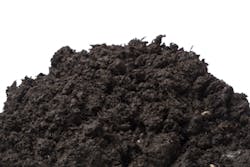Retaining Walls: What You See and What You Don’t – Part 2
Engineered Wall Systems
When a retaining wall is built as part of a large development project, work often proceeds in stages. Gary D. Pritt, general manager of New Dimension, a contractor in Mint Hill, NC, used products from RidgeRock Retaining Walls in Charlotte, NC, to build 80,000 sqaure feet of retaining wall in the first phase of Charleston Places at Vallantyne, an upscale residential townhouse community in Charlotte. “We’re now building the second phase, which has an additional 25,000 square feet of retaining wall,” says Pritt. “Charlotte is on a hilly sandy-clay soil plateau.
“We had to blast rock to construct a wall 30 feet wide and 45 feet deep. The project cost about $1.5 million just for the retaining wall. It took us about six months to build phase one.”
Stone was blasted to permit installation of a geogrid. “We crushed the stone on the site and backfilled it in. There have been no drainage problems. Twenty-five degrees Farenheit is cold here, and there is not much frost. The site is on private property, so there has been no traffic problem.”
Pritt also used RidgeRock at Hunter Crossing in Charlotte, where his firm had to move temporary holding ponds while building a 25,000-square-foot retaining wall about 1,500 foot long and up to 35 foot tall.
“We had to start construction before the ponds were removed,” he says. “The trick was to build one wall, move the pond, and then build the other wall across where the pond had been. We had to undercut to build the walls. The project cost about $300,000 and took about three months. The only thing out of the ordinary was diverting the water and containing it.”
The owners of RidgeRock Retaining Walls launched their company in 1979 as a reinforced-soil business and added retaining walls in 1998. “We are developers, marketers, and the patent holder for the Ridgerock Retaining Wall system,” says Jim Martin, P.E., one of the owners.
Working Around the Weather
In cold climates like Minnesota, freeze/thaw cycles present special challenges for wall construction and drainage. “We do interlocking retaining wall installations between freezes. It is our challenge in our climate to make sure retaining walls stay in place,” explains Clint D. Ernst, president of Custom Retaining Walls and Landscape Corporation in Rochester, MN. “We build our walls on the original grade. Walls are only as good as what they sit on. In our climate, where the ground is frozen part of the year, it is critical to have good drainage from behind the wall. Otherwise moisture captured behind the wall will freeze. Frozen water expands and will push on the wall, forcing the wall in just a few years to begin to fail.
“There is an automatic setback when we install walls so that when the thaw occurs, the wall is pushed forward. When a retaining wall is properly drained of any moisture caught behind the wall, it will drain rather than freeze.”
Concrete products, he says, should be from the same run so they will look the same and have the same humidity level and other characteristics.
“We hold up bigger walls with geogrid and geotextiles laid underground into the hillside. The longer the length of the wall, the longer the grid length.” Other challenges, he notes, include working on hillsides, as they present traction problems for backhoes and lack level surfaces for skid loaders with tracks. Getting large trucks close to the site to haul in materials also can be difficult.
“This whole area is compacted. When the ground is not properly compacted and the grid works its way up as the ground settles, the grid will start to pull back from the wall, and the wall can fail. It can fall back into the hillside, and gaps will develop in the wall.”
Custom Retaining Walls is an employee-owned company that works primarily in southern Minnesota using products from Rockwood Retaining Walls Inc. of Rochester, MN. Rockwood traces its history to Rochester Silo, a farm-structure company founded in 1914. The Price family purchased the firm in 1949 and later changed the name to project the evolution of its business into the manufacture and sale of retaining wall systems.
“We use the same equipment to make retaining wall systems that they used to make farm structures,” says Rockwood’s Greg Ernst, who is Clint Ernst’s brother. “The segmental wall industry’s sales are growing 10 to 15% a year. Industry providers are private and secretive, so no one knows exactly what the real figures are, but a good guess is that 120 million square feet of retaining walls a year are sold.”


